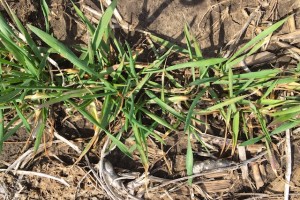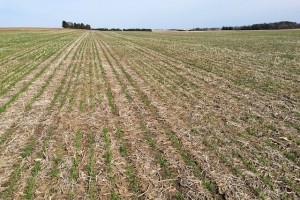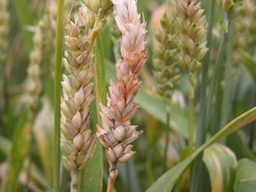New Forecasting System for Fusarium Head Blight Now Available
Damon Smith, Extension Field Crops Pathologist, Department of Plant Pathology, University of Wisconsin-Madison
Fusarium head blight (FHB or scab) was a very damaging disease for many winter wheat growers in Wisconsin in 2014. This disease is caused by a fungus called Fusarium graminearum and infects the heads when the wheat flowers are open. Not only does the colonization of the fungus into the grain cause a reduction in kernel size and overall development, but also the fungus can produce a toxin called deoxynivalenol or vomitoxin. Vomitoxin can be extremely toxic to not only humans, but also livestock. For more information about the specific biology and management of FHB, CLICK HERE to download a fact sheet.
One of the primary methods of controlling FHB in-season is to spray fungicide. Much work has been done by university extension pathologists to determine the best time to spray fungicide to control the disease. It turns out that fungicides targeted at the anthesis (beginning flowering stage or Feekes 10.5.1) period do a good job of protecting the plants and controlling FHB. Additionally, we now know that fungicide applications up to 5 days after anthesis can also be effective in controlling FHB. Application of fungicide 7-10 days after anthesis will offer minimal control based on university research trials sponsored by the US Wheat and Barley Scab Initiative. For a list of products with efficacy on FHB, consult the 2015 Small Grains Fungicide Efficacy Table BY CLICKING HERE.
As you can tell, the timing of application of fungicide is critical for controlling FHB. You can apply the best product available, but if it goes on too early or too late, the application will be wasted. Furthermore, in some years, weather conditions will not be conducive for onset of FHB. This means that if it is really dry during the anthesis (flowering) period, infection by the FHB fungus will be low and little disease will develop. An application during dry weather at flowering will mostly be unnecessary. In order to assist growers and consultants on making fungicide application decisions to control FHB, an online FHB forecasting tool was developed. The tool can be found here: http://www.wheatscab.psu.edu.
In previous years, the tool has tended to under-predict FHB infection events and under-represent the amount of FHB in Wisconsin. After more data was collected and new models were assembled, a new version of the FHB forecasting system has just been released to try to improve the accuracy of the FHB forecasting system. This new 2015 release is now active and functions automatically when you visit the link above. An additional change for 2015 in the winter wheat model is the addition of susceptibility levels for the winter wheat variety you are growing. Previously, the ‘susceptibility’ choice was not available for winter wheat. Consult your seed guide to determine the level of susceptibility for your variety in order to make this input. If you can’t find this rating, then simply choose ‘susceptible. After reviewing the model and the new forecasting system at our annual wheat disease workers meeting, I think that this system is a good improvement over the other forecasting system. I believe that this system has a model with better predictive accuracy. Of course, this does not mean that it can’t fail, but should be a good tool for decision-making purposes. Remember, that your working knowledge and previous experiences are still good predictors of FHB. So even if the model is saying that risk is low and your gut says it is high, go with the ‘boots-on-the-ground’ observations and your gut.
The best time to consult the FHB forecasting system is prior to heading, and through the anthesis period. Begin consulting the model when wheat is in the boot to get a feel for the risk conditions that lead up to the flowering period in your area. Once heads have emerged and flowers are beginning to open, daily consultation of the model can assist in making that decision to spray during that critical Feekes 10.5.1 timing.
You should find the model fairly easy to use. After clicking on http://www.wheatscab.psu.edu you will be brought to the main page (Fig. 1). Enter your state (step 1) and then choose the wheat class (winter or spring) in step 2 (Fig 2). The model will update in real-time, giving you color coded risk levels. You can also choose a forecast (up to 72 hours ahead) in step 3 (Fig. 2). Additionally, your state wheat pathologist will have most likely written a commentary in the text box at the top of the page, once you have chosen your state. In Wisconsin, I try to update this weekly, especially during the critical time for controlling FHB. Remember to keep scouting and paying attention to the weather, in addition to consulting the FHB forecasting system. Here’s to an FHB-free season!







